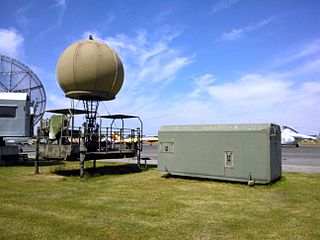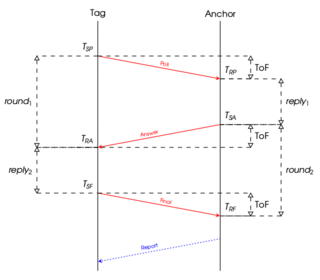Related Research Articles

The Global Positioning System (GPS), originally Navstar GPS, is a satellite-based radionavigation system owned by the United States government and operated by the United States Space Force. It is one of the global navigation satellite systems (GNSS) that provides geolocation and time information to a GPS receiver anywhere on or near the Earth where there is an unobstructed line of sight to four or more GPS satellites. It does not require the user to transmit any data, and operates independently of any telephonic or Internet reception, though these technologies can enhance the usefulness of the GPS positioning information. It provides critical positioning capabilities to military, civil, and commercial users around the world. Although the United States government created, controls and maintains the GPS system, it is freely accessible to anyone with a GPS receiver.

Radio navigation or radionavigation is the application of radio frequencies to determine a position of an object on the Earth, either the vessel or an obstruction. Like radiolocation, it is a type of radiodetermination.

A radio clock or radio-controlled clock (RCC), and often (incorrectly) referred to as an atomic clock is a type of quartz clock or watch that is automatically synchronized to a time code transmitted by a radio transmitter connected to a time standard such as an atomic clock. Such a clock may be synchronized to the time sent by a single transmitter, such as many national or regional time transmitters, or may use the multiple transmitters used by satellite navigation systems such as Global Positioning System. Such systems may be used to automatically set clocks or for any purpose where accurate time is needed. RC clocks may include any feature available for a clock, such as alarm function, display of ambient temperature and humidity, broadcast radio reception, etc.
True-range multilateration is a method to determine the location of a movable vehicle or stationary point in space using multiple ranges (distances) between the vehicle/point and multiple spatially-separated known locations. Energy waves may be involved in determining range, but are not required.
Radiolocation, also known as radiolocating or radiopositioning, is the process of finding the location of something through the use of radio waves. It generally refers to passive uses, particularly radar—as well as detecting buried cables, water mains, and other public utilities. It is similar to radionavigation, but radiolocation usually refers to passively finding a distant object rather than actively one's own position. Both are types of radiodetermination. Radiolocation is also used in real-time locating systems (RTLS) for tracking valuable assets.
The angle of arrival (AoA) of a signal is the direction from which the signal is received.
A tracking system, also known as a locating system, is used for the observing of persons or objects on the move and supplying a timely ordered sequence of location data for further processing. It is important to be aware of human tracking, further details are listed below.

Ramona was the second generation Czechoslovak electronic support measures (ESM) system that uses measurements of time difference of arrival (TDOA) of pulses at three or four sites to accurately detect and track airborne emitters by multilateration.
Tamara was the third generation Czechoslovak electronic support measures (ESM) system that used measurements of time difference of arrival (TDOA) of pulses at three or four sites to accurately detect and track airborne emitters by multilateration. Tamara's designations were KRTP-86 and KRTP-91 and it carried the NATO reporting name of Trash Can. The designation was derived from the Czech phrase "Komplet Radiotechnického Průzkumu" meaning "Radiotechnical Reconnaissance Set". It was claimed to be the only one in the world able to detect military "invisible aircraft".
Multilateration is a technique for determining a "vehicle's" position based on measurement of the times of arrival (TOAs) of energy waves traveling from (navigation) or to (surveillance) multiple system stations having synchronized "clocks". Multilateration is: abbreviated MLAT; more completely termed pseudo-range multilateration; and also termed hyperbolic positioning.

Acoustic location is the use of sound to determine the distance and direction of its source or reflector. Location can be done actively or passively, and can take place in gases, liquids, and in solids.
In serial communication of digital data, clock recovery is the process of extracting timing information from a serial data stream itself, allowing the timing of the data in the stream to be accurately determined without separate clock information. It is widely used in data communications; the similar concept used in analog systems like color television is known as carrier recovery.
Frequency difference of arrival (FDOA) or differential Doppler (DD), is a technique analogous to TDOA for estimating the location of a radio emitter based on observations from other points.. TDOA and FDOA are sometimes used together to improve location accuracy and the resulting estimates are somewhat independent. By combining TDOA and FDOA measurements, instantaneous geolocation can be performed in two dimensions.
Near-field electromagnetic ranging (NFER) refers to any radio technology employing the near-field properties of radio waves as a Real Time Location System (RTLS).

An indoor positioning system (IPS) is a network of devices used to locate people or objects where GPS and other satellite technologies lack precision or fail entirely, such as inside multistory buildings, airports, alleys, parking garages, and underground locations.

In radio technology, symmetrical double-sided two-way ranging (SDS-TWR) is a ranging method that uses two delays that naturally occur in signal transmission to determine the range between two stations:
Real-time locating systems (RTLS), also known as real-time tracking systems, are used to automatically identify and track the location of objects or people in real time, usually within a building or other contained area. Wireless RTLS tags are attached to objects or worn by people, and in most RTLS, fixed reference points receive wireless signals from tags to determine their location. Examples of real-time locating systems include tracking automobiles through an assembly line, locating pallets of merchandise in a warehouse, or finding medical equipment in a hospital.
Enhanced Observed Time Difference (E-OTD) is a standard for the location of mobile telephones. The location method works by multilateration. The standardisation was first carried out for GSM by the GSM standard committees in LCS Release 98 and Release 99. The standardisation was continued for 3G and WCDMA mobile telephones by 3GPP.
Satellite geolocation is the process of locating the origin of a signal appearing on a satellite communication channel. Typically, this process is used to mitigate interference on communication satellites. Usually, these interference signals are caused by human error or equipment failure, but can also be caused by deliberate jamming. Identifying the geographical location of an interfering signal informs the mitigation activity.

Hyperbolic navigation is a class of radio navigation systems in which a navigation receiver instrument is used to determine location based on the difference in timing (phase) of radio waves received from radio navigation beacon transmitters.